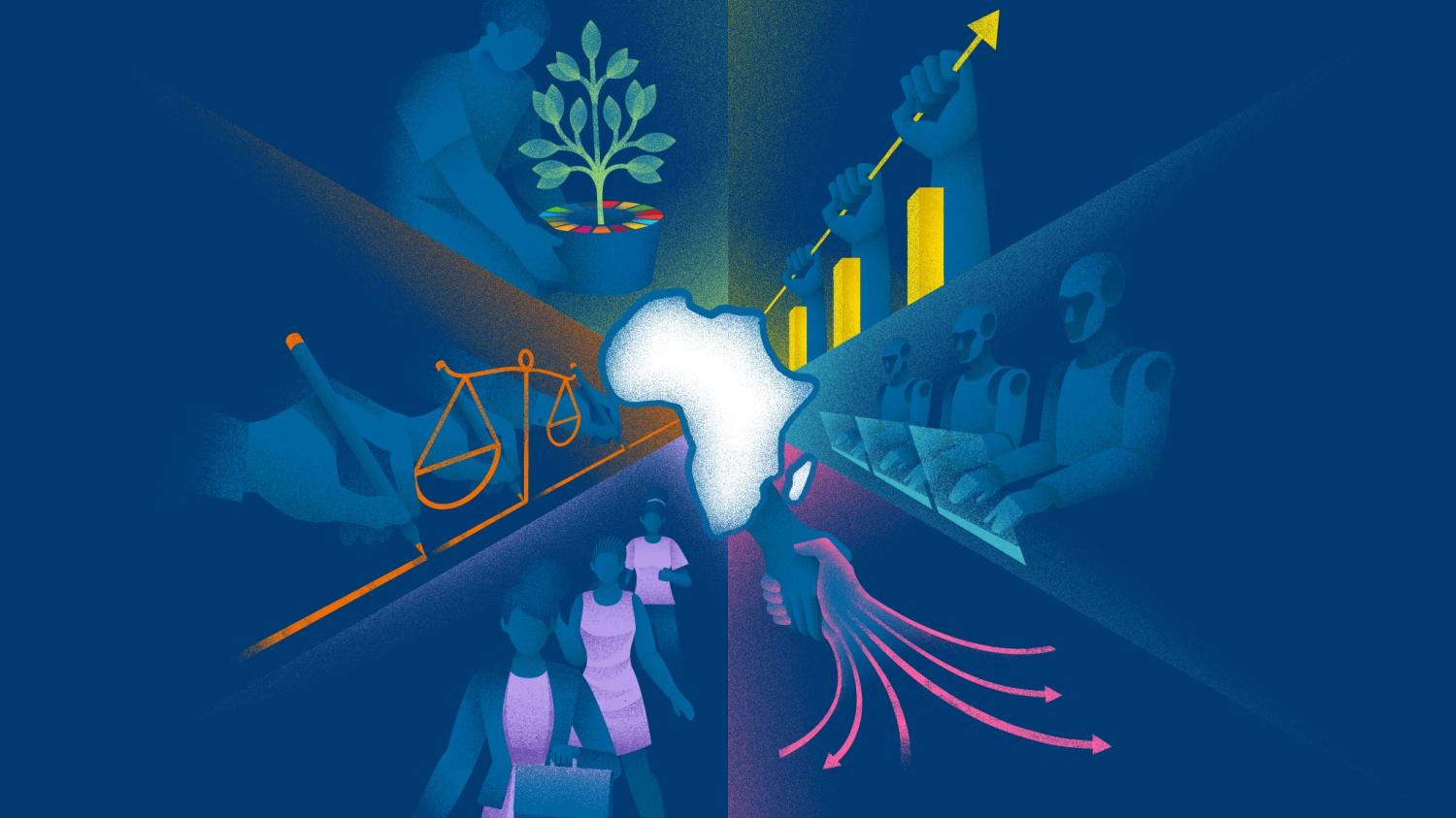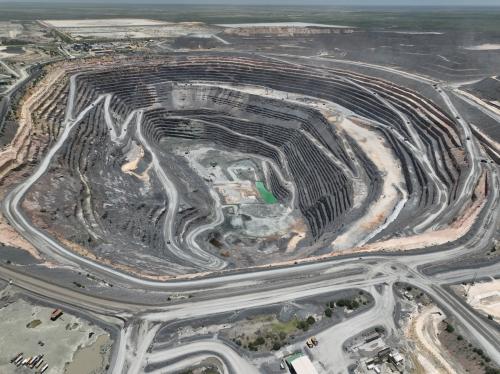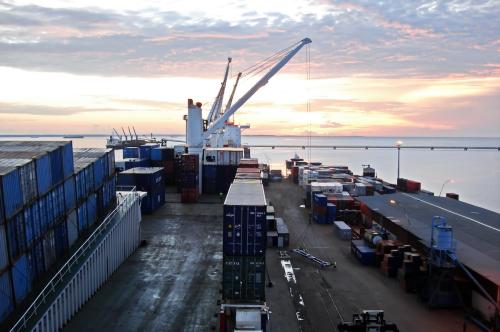This viewpoint is part of Chapter 1 of Foresight Africa 2025-2030, a report with cutting-edge insights and actionable strategies for Africa’s inclusive and sustainable development in the run-up to 2030. Read the full chapter on Africa’s inner strength.
Africa is a key player in the energy transition, holding approximately 30% of the world’s largest mineral reserves.
Africa stands at the crossroads of the transformation required by the global green revolution agenda, spurred by climate change imperatives and the rapid shift toward clean energy technologies. The demand for critical or “green”1 minerals, such as lithium, cobalt, copper, nickel, graphite, and rare earth elements, is surging,2 driven by the rise of electric vehicles, renewable energy systems, and energy storage solutions across the world. Africa is a key player in the energy transition, holding approximately 30% of the world’s largest mineral reserves,3 including 70% of cobalt.4 The critical minerals race presents an immense opportunity for Africa to go beyond extraction. Africa could become a global hub for critical mineral processing and the production of green technologies through a vertically integrated value chain that includes mining, processing, manufacturing, and technology development. However, Africa must act proactively, decisively, and quickly to secure its place in the global minerals value chains.
Africa’s visions and strategies such as Agenda 2063,5 the Africa Mining Vision (AMV),6 the African Commodity Strategy, and the forthcoming African Green Minerals Strategy (AGMS) collectively emphasize the need for Africa to transform its mineral wealth into sustainable, value-added industries.7 The AGMS specifically highlights the importance of positioning Africa as a key player in the green transition, advocating for the responsible extraction and processing of green minerals while promoting industrialization and green technology development.
What will it take? By 2030, African policymakers must adopt innovative approaches to fully implement these strategies by developing coherent policies at all levels to ensure that the ecosystems around value addition and industrialization are developed, including the requisite infrastructure, skills, technology, regional cooperation, and capital. Since channeling domestic private savings into productive sectors through Africa’s capital markets is one of the best avenues for domestic resource mobilization, the African Minerals and Energy Classification and Management System8 and the Pan-African Reporting Code by the African Minerals Development Centre9 will be pivotal and transformative for facilitating access to African capital markets. Standardizing resource estimation and reporting across Africa will create frameworks that bolster investor confidence by enhancing transparency and governance in Africa’s critical minerals sector and unlock the continent’s capital markets, leading to value addition and economic diversification.10 Public-private partnerships and joint ventures are also essential for mobilizing the necessary capital.11 African governments should tap into the growing climate finance market by aligning national goals with those of global climate.
Lastly, regional cooperation is vital for Africa to benefit from the critical minerals race. The African Continental Free Trade Area should be leveraged to foster intra-African collaboration to build integrated value chains, share best practices, and pool resources for large-scale projects.12 The development of regional hubs for mineral processing and manufacturing will boost Africa’s global competitiveness.
-
Footnotes
- In the AU’s forthcoming African Green Minerals Strategy (AGMS), green minerals are those that are used in cleanenergy technologies and green industries, and those that are feedstocks into the mining supply chain. The draft AGMS will be introduced for adoption by Ministers at an Extraordinary Specialized Technical Committee meeting of Trade, Industry, and Minerals on December 9-13, 2024, in Ethiopia.
- Mineral demand for clean energy technologies is expected to almost triple by 2030 and quadruple by 2040. See: “Global Critical Minerals Outlook 2024,” (Paris: IEA, May 2024). https://iea.blob.core.windows.net/assets/ee01701d1d5c-4ba8-9df6-abeeac9de99a/GlobalCriticalMineralsOutlook2024.pdf.
- “Our Work in Africa,” United Nations Environment Programme, accessed December 13, 2024, https://www.unep.org/ regions/africa/our-work-africa.
- “Approach Paper towards Preparation of an African Green Minerals Strategy” African Natural Resources Management and Investment Centre, (Abidjan: African Development Bank, December 2022), https://www.afdb.org/sites/default/ files/documents/publications/approach_paper_towards_preparation_of_an_african_green_minerals_strategy.pdf.
- “Agenda 2063: The Africa We Want,” African Union, accessed December 13, 2024, https://au.int/en/agenda2063/overview.
- Africa Mining Vision 2009” (African Union, February 2009). https://au.int/en/ti/amv/about.
- Directorate of Information and Communication, “Africa’s Commodities Strategy; Value Addition for Global Competitiveness.” African Union, September 2, 2021, https://au.int/en/pressreleases/20210902/africas-commoditiesstrategy-value-addition-global-competitiveness; “Approach Paper towards Preparation of an African Green Minerals Strategy.”
- “African Mineral and Energy Resources Classification and Management System (AMREC)” (African Union, August 31, 2019), https://au.int/sw/node/44206.
- “Launch of the Pan African Resource Reporting Code” (African Union, April 3, 2024), https://au.int/en/ newsevents/20240403/launch-pan-african-resource-reporting-code.
- Barbara Buchner et al., “Global Landscape of Climate Finance 2023” (Climate Policy Initiative, November 2, 2023), https://www.climatepolicyinitiative.org/publication/global-landscape-of-climate-finance-2023/.
- “Mobilizing the Private Sector to Drive Development in Africa,” World Bank, December 1, 2023, https://projects. worldbank.org/en/results/2023/12/01/mobilizing-the-private-sector-to-drive-development-in-africa.
- “About the AfCFTA,” African Union, accessed December 3, 2024, https://au-afcfta.org/about/.
The Brookings Institution is committed to quality, independence, and impact.
We are supported by a diverse array of funders. In line with our values and policies, each Brookings publication represents the sole views of its author(s).





Commentary
Africa’s strategic positioning in the global green revolution and critical minerals race
March 19, 2025